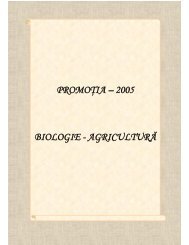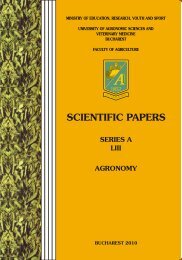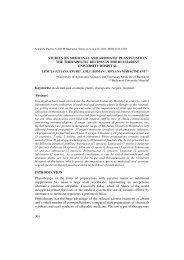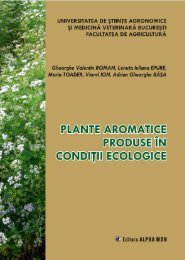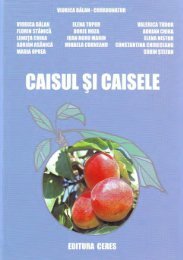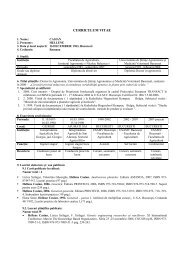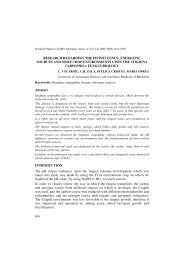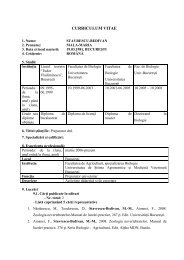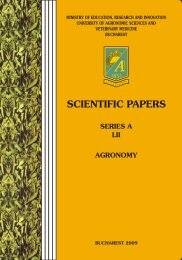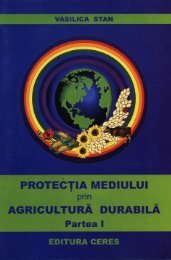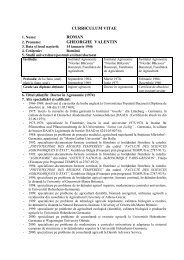THE MANAGEMENT OF SOIL QUALITY IN AGRICULTURAL ...
THE MANAGEMENT OF SOIL QUALITY IN AGRICULTURAL ...
THE MANAGEMENT OF SOIL QUALITY IN AGRICULTURAL ...
Create successful ePaper yourself
Turn your PDF publications into a flip-book with our unique Google optimized e-Paper software.
Scientific Papers, USAMV Bucharest, Series A, Vol. LII, 2009, ISSN 1222-5339-9<br />
<strong>THE</strong> <strong>MANAGEMENT</strong> <strong>OF</strong> <strong>SOIL</strong> <strong>QUALITY</strong> <strong>IN</strong> <strong>AGRICULTURAL</strong><br />
EXPLOITATIONS FROM <strong>THE</strong> SOU<strong>THE</strong>RN PART <strong>OF</strong> DOLJ DISTRICT<br />
298<br />
I. SARAC<strong>IN</strong>*, OLIMPIA PANDIA*, M. GHEORGHE**, F. GHEORGHE***<br />
*University of Craiova, Faculty of Agriculture<br />
**Politehnica University of Bucharest<br />
***University of Galati<br />
Keywords: management, indicators, structure, erosion, retention of nutrients<br />
Abstract<br />
The paper was realised having as departure point the map of soils from the South of<br />
Oltenia, processed with the aid of SIG. The South area of district Dolj, though its<br />
geographical position it is situated under the influence of an excessive natural ground with<br />
annual average temperatures that are high enough, average annual precipitation of 400-<br />
500 mm and the value of the small aridity index is considered to be one of the most<br />
predisposed areas at the process of soil degradation due to phenomena of drought – aridity<br />
– desert. Work of improvement and preservation of the soils must be advisable realised.<br />
<strong>IN</strong>TRODUCTION<br />
The management of soil quality refers to the selection of the adequate agricultural<br />
practices, correspondent to the modality of usage the agricultural field, depending<br />
on soil types for the territory of each agricultural exploitation. The evaluation of<br />
the management of the soil quality represents the process of measuring the changes<br />
that took place in the quality of the soil, as a result of the agricultural practices<br />
adopted for the improvement of the economical performances obtained for the<br />
same field surface.<br />
For the identification of the properties or the key attributes of soil, sensible to<br />
exchange the function of the soil will be recommended the research of a minimum<br />
set of indicators, of primordial interest for the farmer.<br />
Indicators selected for evaluation of the management of soil quality must show<br />
which are the present performances of the soil and how can be preserved and<br />
improved their functions for future usage. The selected indicators can refer to<br />
physical, chemical, biological characteristics or at processes that took place at the<br />
level of the soil. In table 1 is presented a set of indicators regarding the main<br />
characteristics of the health status of the soil.
Indicators of the soil quality<br />
Table 1<br />
Indicator Relationship with the main characteristics of<br />
the soil status health<br />
Organic mater from the soil Fertilization of the soil, structure, erosion,<br />
retention of nutrients.<br />
Physical: structure of the soil, capacity of<br />
infiltration of the water, capacity of durable<br />
maintenance of the water, apparent density.<br />
Chemical: pH, electrical conductance, supply<br />
with nutrient elements.<br />
Biological: High degree of ensuring with N, the<br />
degree of the soil.<br />
Processing according to Larson and Pierce, 1994 and Seybold 1994<br />
MATERIAL AND METHODS<br />
Retention and transportation of the soil and the<br />
nutrients; compaction degree, porosity, hob of the<br />
plough, depth at which can be plough<br />
Available level of fertility, degrees regarding the<br />
requirements of the main cultures regarding the<br />
reaction of the soil, threshold of biological and<br />
chemical activity.<br />
Measuring the microbiological activities,<br />
productivity of the soil and the degree of<br />
satisfaction with N.<br />
The paper was realised having as departure point the map of soils from the South<br />
Oltenia, processed with the aid of SIG.<br />
Fig. 1. Aspects on the sandy soils (ploughing in autumn) on the<br />
South zone in Dolj County<br />
The drought is a natural phenomenon that in the past affected periodically the S-W<br />
and S-E of Romania, being able to mention the period of severe drought: 1894-<br />
1905; 1942-1945; and the most recent 1981-2001. The South area of district Dolj is<br />
not an exception regarding these drought phenomena. Though its geographical<br />
position it is situated under the influence of an excessive natural ground with<br />
annual average temperatures that are high enough, average annual precipitation of<br />
400-500 mm and the value of the small aridity index is considered to be one of the<br />
299
most predisposed areas at the process of soil degradation due to drought<br />
phenomenon of drought – aridity – desert.<br />
Fig. 2. The distortion of sandy soils under the tractors wheel action<br />
The process of degradation of the soil, due to this phenomenon is defined as the<br />
actual or potential loss of productivity or the utility of the soil of the natural and<br />
atrophic factors.<br />
Fig. 3. The affectation of strawberry crop, in winter because of the wind and<br />
frost<br />
The main processes that can aid the development of the phenomenon of<br />
degradation – desert can be identified in:<br />
- biological degradation through the loss of organic substance;<br />
300
Fig. 4. The effect on using mulch in the folio and the wind on the sandy soils<br />
- physical degradation due to structure<br />
Fig. 5. Rests of folio on the surface of pouching soil<br />
The degradation of the soil through the reduction of the content of organic<br />
substance has as main factors that can be identified: excessive use of the<br />
agricultural works or of others measures of agro-techniques measures, accelerated<br />
erosion of the soil, due to long periods of activity of the wind in this area, excessive<br />
and inadequate application of other measures of agro techniques, the accelerated<br />
erosion of the soil due to long periods of activity of the wind in this area, excessive<br />
and inadequate application of chemical fertilisers, herbicides and insecticides.<br />
The massive content of organic matter can be associated with the intensive usage<br />
of the tillage, of leaving the uncultivated field during summer time, burning the<br />
stubble filed, etc. The influence of the texture on the processed of soil degradation<br />
is presented through at least 2 reasons:<br />
- the size and the modalities of disposure of the soil particles that at<br />
vulnerable at the action of the wind and water;<br />
301
Fig. 6. The action of spring wind on the sandy soils<br />
- the modification of the potential of retention of the water, making possible<br />
surface drainages.<br />
The main factors that are responsible for the degradation of the sandy soils from<br />
the South of Oltenia, can be considered:<br />
- the uncontrolled and excessive tillage;<br />
Fig. 7. Aspects of vegetation, on the spring, on the soil pouching in autumn<br />
- using on a large scale of the breeding cultures that involve a high degree of<br />
mechanization of the culture technology;<br />
- eolian deflation;<br />
- soil contamination by excessive usage of the chemical fertilizers.<br />
In the same time, the soil represents the main source of herbs in the cultures, due to<br />
the reserve of herbs seeds from the soil, reserve that can be used for the realization<br />
of the green areas, of protection of the cultures through eolian deflation, by<br />
application of some specific technologies in that area and leaving some<br />
unprocessed surfaces in which high herbs will be developed up to the blossom<br />
period, when will be destroyed.<br />
302
Fig. 8. Foundation of protection bands trip, in the autumn, with sowing<br />
The determination of the total reserve of seeds of grass in the soil on the layer of 0-<br />
10 cm, was realized taking into account the application of the basic works of the<br />
soil in the classical system and in the minimal system of works. The results<br />
obtained after the determination realized show that the reserve of seeds of grass<br />
from the soil is influenced by the system of applied works.<br />
CONCLUSIONS<br />
1. Work of improvement and preservation of the soils must be advisable<br />
realised.<br />
2. It is imposed that a part of these fields, with reduced fertility capacity be<br />
passed in the forester filed and to facilitate the foundation of protection<br />
curtains.<br />
3. From the agro technical point of view, grasses that will be developed on<br />
these soils can be used for the foundation of green areas for the protection of<br />
the cultures.<br />
4. The results of the researches offer a support for the possibility of promotion<br />
of new - village technology, with an efficient management.<br />
REFERENCES<br />
1. Oprean A., 1972. Hydraulic driving. Driving hydraulic elements. Publishing House,<br />
Bucharest.<br />
2. Popescu S. and others, 1972. Driving and automatics. Publishing House, Bucharest.<br />
3. Radu M. şi colab., 1968. Motoare pentru automobile şi tractoare. Ed. Didactică şi<br />
Pedagogică, Bucureşti.<br />
4. Sărăcin I., 1999. Energetic base for agriculture. Publishing House Europa.<br />
303



